Coursework on Personal Stress Management in Professional Settings
VerifiedAdded on 2023/06/03
|11
|2273
|362
Report
AI Summary
This report delves into the multifaceted nature of personal stress management, particularly within professional environments. It begins by defining workplace stressors and their impact, including poor equipment, relationships with colleagues, and organizational changes. The report then explores the body's physiological and psychological responses to stress, detailing the roles of the hypothalamus, adrenal glands, and various hormones. It identifies long-term health effects of prolonged stress, such as cardiovascular diseases, mental health issues, and gastrointestinal problems. The report highlights strategies and services available to help manage stress, including cognitive-behavioral interventions, psychological therapies, and employee assistance programs. Self-care techniques such as exercise, diet, work-life balance strategies, and alternative health options are also discussed. Furthermore, the report examines stressors that may result in grief or loss, such as occupational and interpersonal stressors. The report concludes by analyzing specific workplace situations and offering strategies for managing stress, addressing staff misbehavior, and understanding workplace rights according to Fair Work Acts. This report provides a comprehensive overview of stress management, equipping individuals with practical knowledge and strategies to mitigate the negative impacts of stress in the workplace.
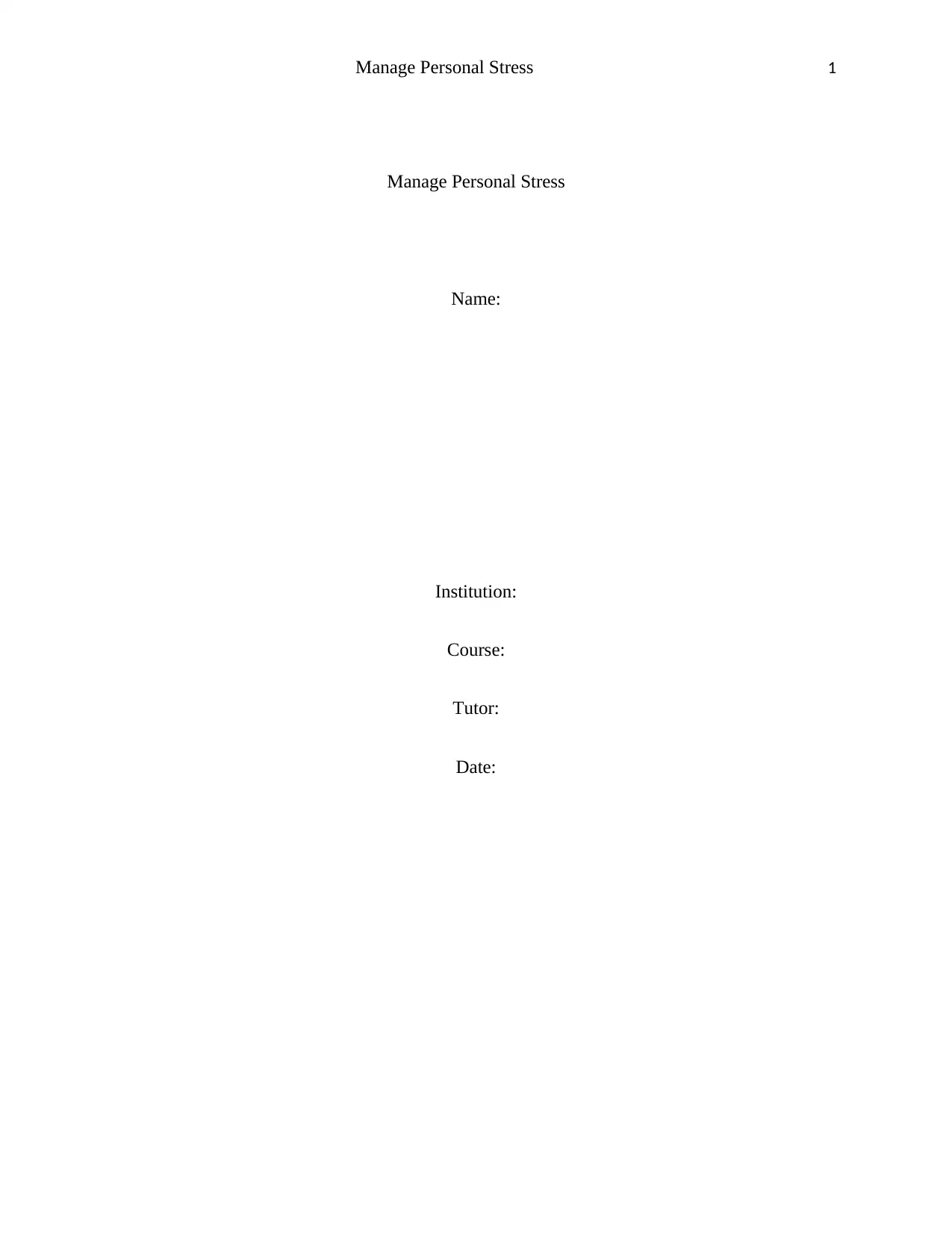
Manage Personal Stress 1
Manage Personal Stress
Name:
Institution:
Course:
Tutor:
Date:
Manage Personal Stress
Name:
Institution:
Course:
Tutor:
Date:
Paraphrase This Document
Need a fresh take? Get an instant paraphrase of this document with our AI Paraphraser
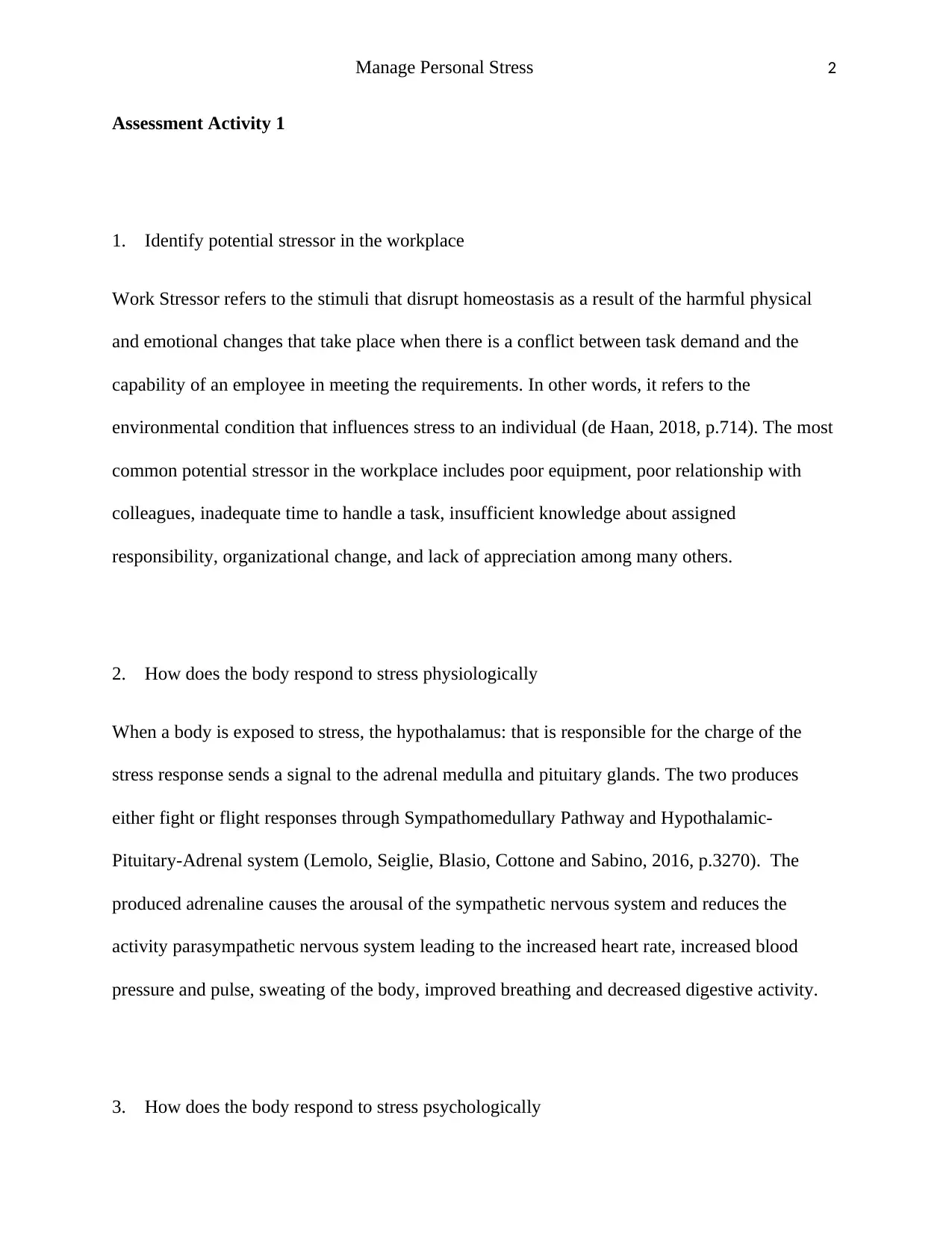
Manage Personal Stress 2
Assessment Activity 1
1. Identify potential stressor in the workplace
Work Stressor refers to the stimuli that disrupt homeostasis as a result of the harmful physical
and emotional changes that take place when there is a conflict between task demand and the
capability of an employee in meeting the requirements. In other words, it refers to the
environmental condition that influences stress to an individual (de Haan, 2018, p.714). The most
common potential stressor in the workplace includes poor equipment, poor relationship with
colleagues, inadequate time to handle a task, insufficient knowledge about assigned
responsibility, organizational change, and lack of appreciation among many others.
2. How does the body respond to stress physiologically
When a body is exposed to stress, the hypothalamus: that is responsible for the charge of the
stress response sends a signal to the adrenal medulla and pituitary glands. The two produces
either fight or flight responses through Sympathomedullary Pathway and Hypothalamic-
Pituitary-Adrenal system (Lemolo, Seiglie, Blasio, Cottone and Sabino, 2016, p.3270). The
produced adrenaline causes the arousal of the sympathetic nervous system and reduces the
activity parasympathetic nervous system leading to the increased heart rate, increased blood
pressure and pulse, sweating of the body, improved breathing and decreased digestive activity.
3. How does the body respond to stress psychologically
Assessment Activity 1
1. Identify potential stressor in the workplace
Work Stressor refers to the stimuli that disrupt homeostasis as a result of the harmful physical
and emotional changes that take place when there is a conflict between task demand and the
capability of an employee in meeting the requirements. In other words, it refers to the
environmental condition that influences stress to an individual (de Haan, 2018, p.714). The most
common potential stressor in the workplace includes poor equipment, poor relationship with
colleagues, inadequate time to handle a task, insufficient knowledge about assigned
responsibility, organizational change, and lack of appreciation among many others.
2. How does the body respond to stress physiologically
When a body is exposed to stress, the hypothalamus: that is responsible for the charge of the
stress response sends a signal to the adrenal medulla and pituitary glands. The two produces
either fight or flight responses through Sympathomedullary Pathway and Hypothalamic-
Pituitary-Adrenal system (Lemolo, Seiglie, Blasio, Cottone and Sabino, 2016, p.3270). The
produced adrenaline causes the arousal of the sympathetic nervous system and reduces the
activity parasympathetic nervous system leading to the increased heart rate, increased blood
pressure and pulse, sweating of the body, improved breathing and decreased digestive activity.
3. How does the body respond to stress psychologically
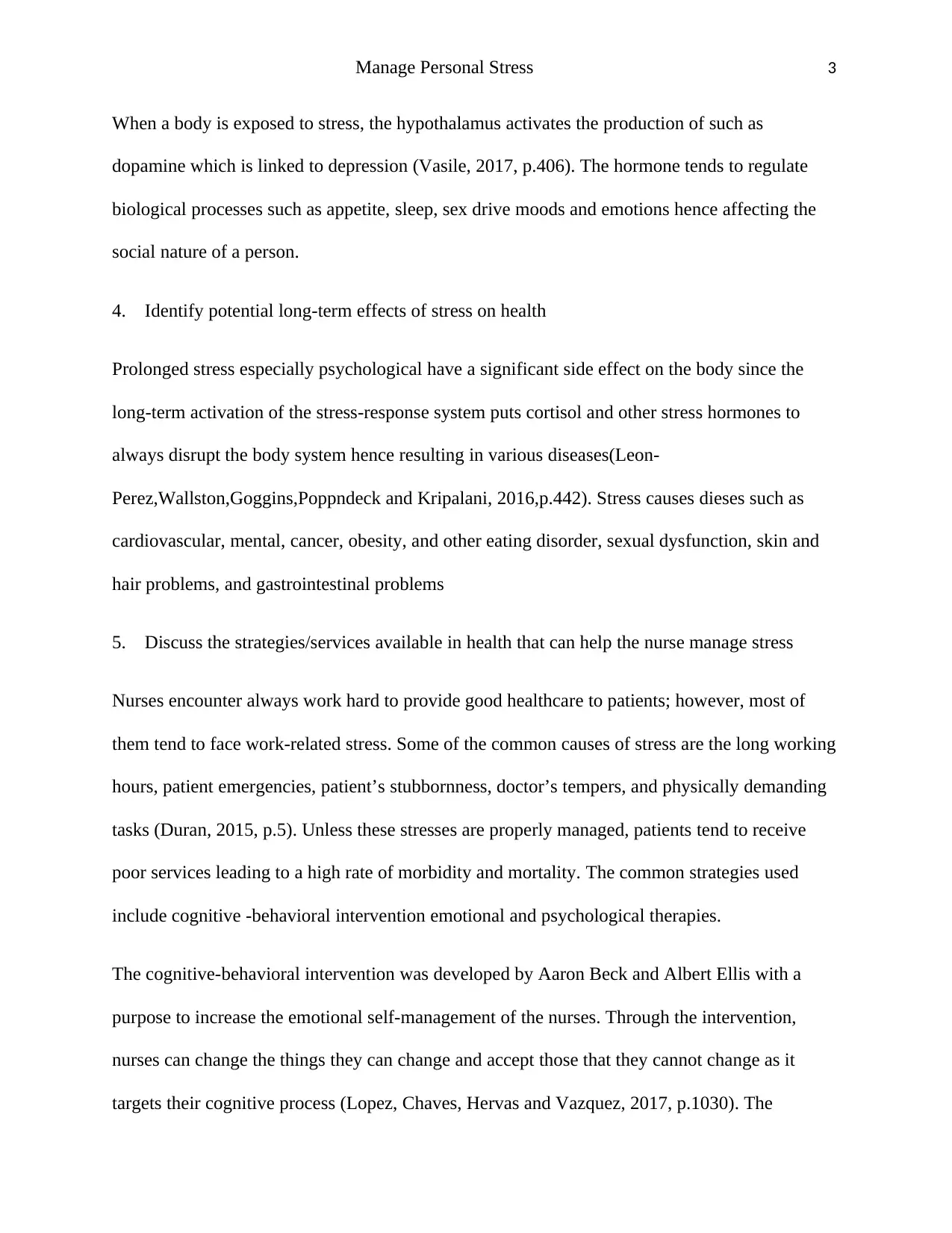
Manage Personal Stress 3
When a body is exposed to stress, the hypothalamus activates the production of such as
dopamine which is linked to depression (Vasile, 2017, p.406). The hormone tends to regulate
biological processes such as appetite, sleep, sex drive moods and emotions hence affecting the
social nature of a person.
4. Identify potential long-term effects of stress on health
Prolonged stress especially psychological have a significant side effect on the body since the
long-term activation of the stress-response system puts cortisol and other stress hormones to
always disrupt the body system hence resulting in various diseases(Leon-
Perez,Wallston,Goggins,Poppndeck and Kripalani, 2016,p.442). Stress causes dieses such as
cardiovascular, mental, cancer, obesity, and other eating disorder, sexual dysfunction, skin and
hair problems, and gastrointestinal problems
5. Discuss the strategies/services available in health that can help the nurse manage stress
Nurses encounter always work hard to provide good healthcare to patients; however, most of
them tend to face work-related stress. Some of the common causes of stress are the long working
hours, patient emergencies, patient’s stubbornness, doctor’s tempers, and physically demanding
tasks (Duran, 2015, p.5). Unless these stresses are properly managed, patients tend to receive
poor services leading to a high rate of morbidity and mortality. The common strategies used
include cognitive -behavioral intervention emotional and psychological therapies.
The cognitive-behavioral intervention was developed by Aaron Beck and Albert Ellis with a
purpose to increase the emotional self-management of the nurses. Through the intervention,
nurses can change the things they can change and accept those that they cannot change as it
targets their cognitive process (Lopez, Chaves, Hervas and Vazquez, 2017, p.1030). The
When a body is exposed to stress, the hypothalamus activates the production of such as
dopamine which is linked to depression (Vasile, 2017, p.406). The hormone tends to regulate
biological processes such as appetite, sleep, sex drive moods and emotions hence affecting the
social nature of a person.
4. Identify potential long-term effects of stress on health
Prolonged stress especially psychological have a significant side effect on the body since the
long-term activation of the stress-response system puts cortisol and other stress hormones to
always disrupt the body system hence resulting in various diseases(Leon-
Perez,Wallston,Goggins,Poppndeck and Kripalani, 2016,p.442). Stress causes dieses such as
cardiovascular, mental, cancer, obesity, and other eating disorder, sexual dysfunction, skin and
hair problems, and gastrointestinal problems
5. Discuss the strategies/services available in health that can help the nurse manage stress
Nurses encounter always work hard to provide good healthcare to patients; however, most of
them tend to face work-related stress. Some of the common causes of stress are the long working
hours, patient emergencies, patient’s stubbornness, doctor’s tempers, and physically demanding
tasks (Duran, 2015, p.5). Unless these stresses are properly managed, patients tend to receive
poor services leading to a high rate of morbidity and mortality. The common strategies used
include cognitive -behavioral intervention emotional and psychological therapies.
The cognitive-behavioral intervention was developed by Aaron Beck and Albert Ellis with a
purpose to increase the emotional self-management of the nurses. Through the intervention,
nurses can change the things they can change and accept those that they cannot change as it
targets their cognitive process (Lopez, Chaves, Hervas and Vazquez, 2017, p.1030). The
⊘ This is a preview!⊘
Do you want full access?
Subscribe today to unlock all pages.

Trusted by 1+ million students worldwide
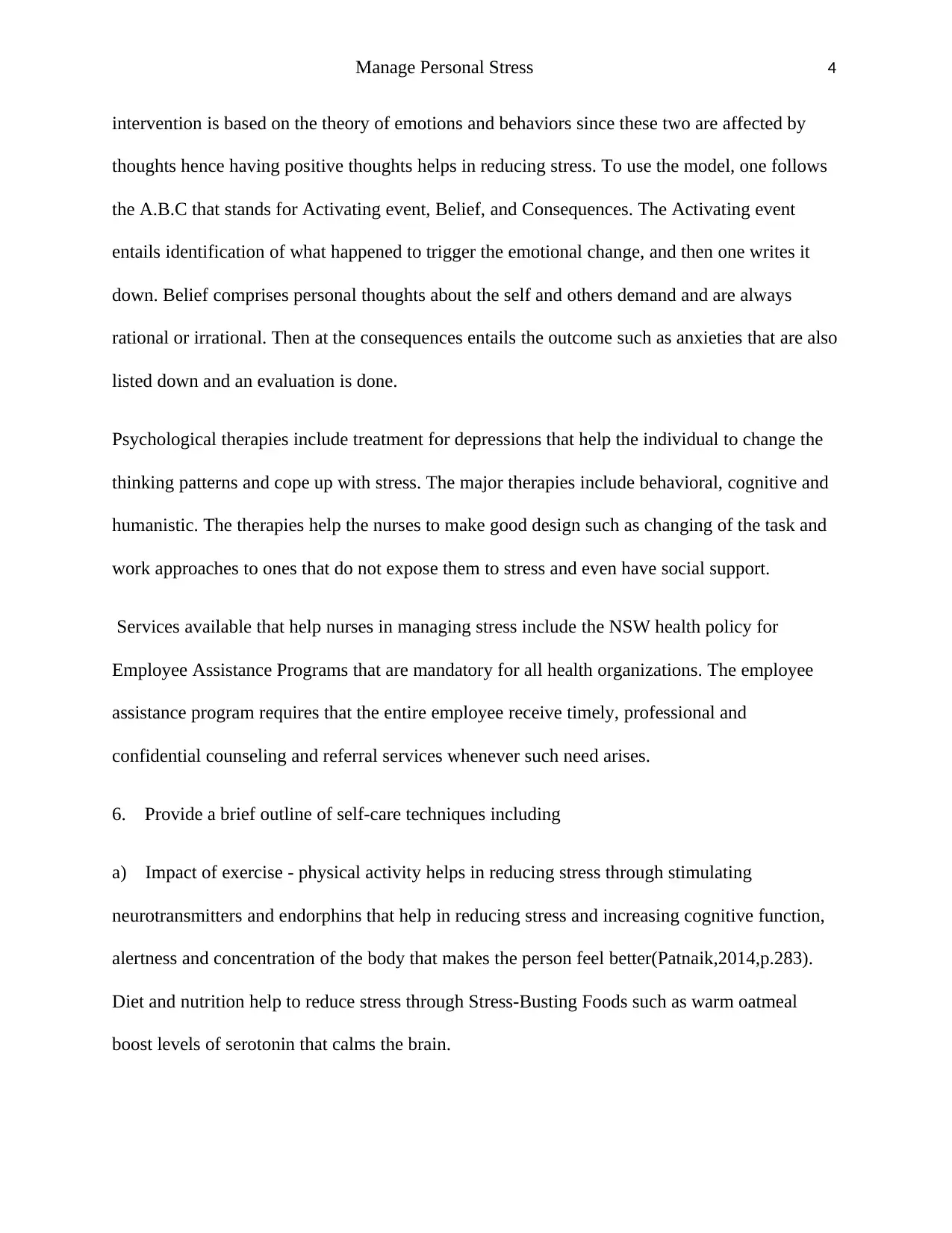
Manage Personal Stress 4
intervention is based on the theory of emotions and behaviors since these two are affected by
thoughts hence having positive thoughts helps in reducing stress. To use the model, one follows
the A.B.C that stands for Activating event, Belief, and Consequences. The Activating event
entails identification of what happened to trigger the emotional change, and then one writes it
down. Belief comprises personal thoughts about the self and others demand and are always
rational or irrational. Then at the consequences entails the outcome such as anxieties that are also
listed down and an evaluation is done.
Psychological therapies include treatment for depressions that help the individual to change the
thinking patterns and cope up with stress. The major therapies include behavioral, cognitive and
humanistic. The therapies help the nurses to make good design such as changing of the task and
work approaches to ones that do not expose them to stress and even have social support.
Services available that help nurses in managing stress include the NSW health policy for
Employee Assistance Programs that are mandatory for all health organizations. The employee
assistance program requires that the entire employee receive timely, professional and
confidential counseling and referral services whenever such need arises.
6. Provide a brief outline of self-care techniques including
a) Impact of exercise - physical activity helps in reducing stress through stimulating
neurotransmitters and endorphins that help in reducing stress and increasing cognitive function,
alertness and concentration of the body that makes the person feel better(Patnaik,2014,p.283).
Diet and nutrition help to reduce stress through Stress-Busting Foods such as warm oatmeal
boost levels of serotonin that calms the brain.
intervention is based on the theory of emotions and behaviors since these two are affected by
thoughts hence having positive thoughts helps in reducing stress. To use the model, one follows
the A.B.C that stands for Activating event, Belief, and Consequences. The Activating event
entails identification of what happened to trigger the emotional change, and then one writes it
down. Belief comprises personal thoughts about the self and others demand and are always
rational or irrational. Then at the consequences entails the outcome such as anxieties that are also
listed down and an evaluation is done.
Psychological therapies include treatment for depressions that help the individual to change the
thinking patterns and cope up with stress. The major therapies include behavioral, cognitive and
humanistic. The therapies help the nurses to make good design such as changing of the task and
work approaches to ones that do not expose them to stress and even have social support.
Services available that help nurses in managing stress include the NSW health policy for
Employee Assistance Programs that are mandatory for all health organizations. The employee
assistance program requires that the entire employee receive timely, professional and
confidential counseling and referral services whenever such need arises.
6. Provide a brief outline of self-care techniques including
a) Impact of exercise - physical activity helps in reducing stress through stimulating
neurotransmitters and endorphins that help in reducing stress and increasing cognitive function,
alertness and concentration of the body that makes the person feel better(Patnaik,2014,p.283).
Diet and nutrition help to reduce stress through Stress-Busting Foods such as warm oatmeal
boost levels of serotonin that calms the brain.
Paraphrase This Document
Need a fresh take? Get an instant paraphrase of this document with our AI Paraphraser
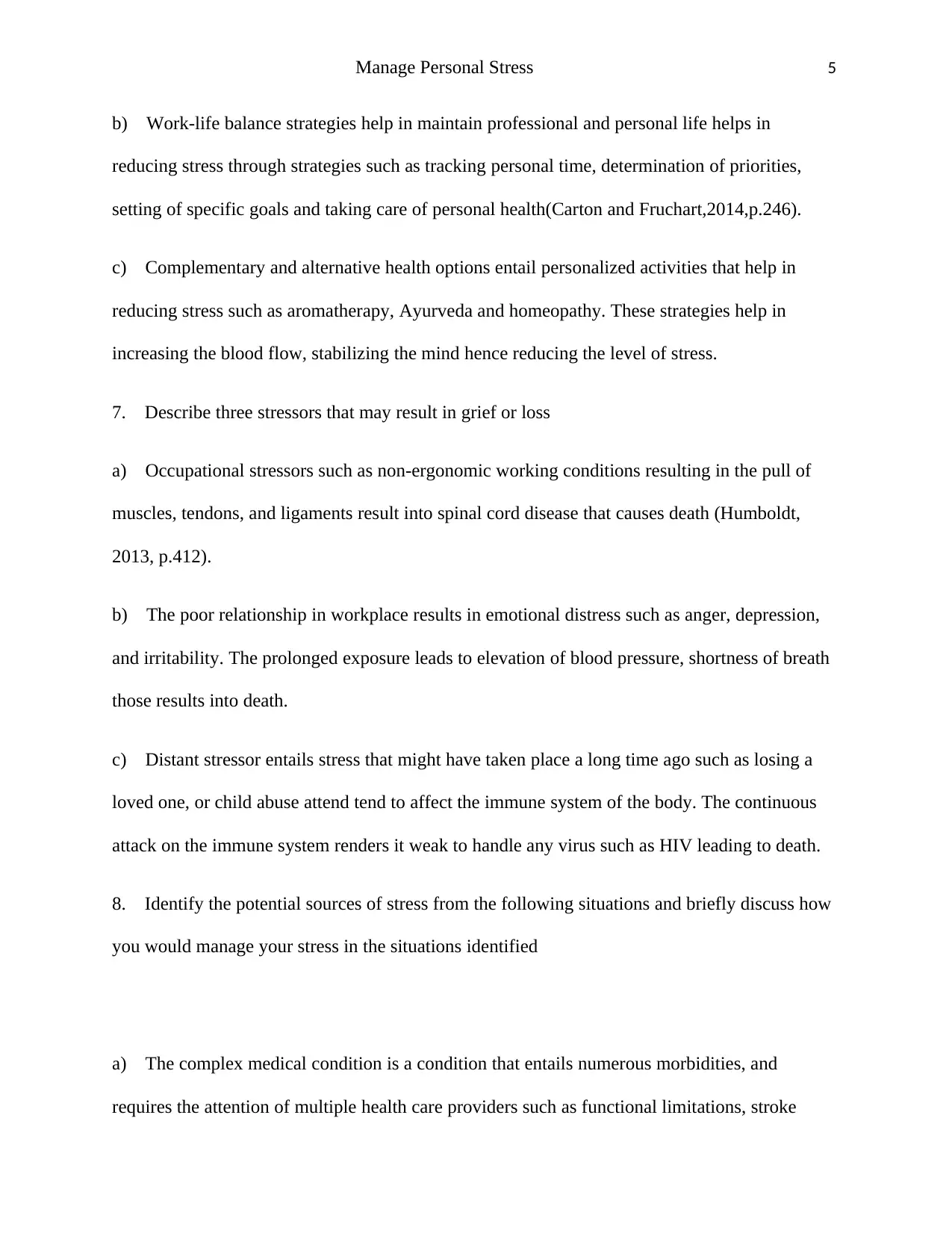
Manage Personal Stress 5
b) Work-life balance strategies help in maintain professional and personal life helps in
reducing stress through strategies such as tracking personal time, determination of priorities,
setting of specific goals and taking care of personal health(Carton and Fruchart,2014,p.246).
c) Complementary and alternative health options entail personalized activities that help in
reducing stress such as aromatherapy, Ayurveda and homeopathy. These strategies help in
increasing the blood flow, stabilizing the mind hence reducing the level of stress.
7. Describe three stressors that may result in grief or loss
a) Occupational stressors such as non-ergonomic working conditions resulting in the pull of
muscles, tendons, and ligaments result into spinal cord disease that causes death (Humboldt,
2013, p.412).
b) The poor relationship in workplace results in emotional distress such as anger, depression,
and irritability. The prolonged exposure leads to elevation of blood pressure, shortness of breath
those results into death.
c) Distant stressor entails stress that might have taken place a long time ago such as losing a
loved one, or child abuse attend tend to affect the immune system of the body. The continuous
attack on the immune system renders it weak to handle any virus such as HIV leading to death.
8. Identify the potential sources of stress from the following situations and briefly discuss how
you would manage your stress in the situations identified
a) The complex medical condition is a condition that entails numerous morbidities, and
requires the attention of multiple health care providers such as functional limitations, stroke
b) Work-life balance strategies help in maintain professional and personal life helps in
reducing stress through strategies such as tracking personal time, determination of priorities,
setting of specific goals and taking care of personal health(Carton and Fruchart,2014,p.246).
c) Complementary and alternative health options entail personalized activities that help in
reducing stress such as aromatherapy, Ayurveda and homeopathy. These strategies help in
increasing the blood flow, stabilizing the mind hence reducing the level of stress.
7. Describe three stressors that may result in grief or loss
a) Occupational stressors such as non-ergonomic working conditions resulting in the pull of
muscles, tendons, and ligaments result into spinal cord disease that causes death (Humboldt,
2013, p.412).
b) The poor relationship in workplace results in emotional distress such as anger, depression,
and irritability. The prolonged exposure leads to elevation of blood pressure, shortness of breath
those results into death.
c) Distant stressor entails stress that might have taken place a long time ago such as losing a
loved one, or child abuse attend tend to affect the immune system of the body. The continuous
attack on the immune system renders it weak to handle any virus such as HIV leading to death.
8. Identify the potential sources of stress from the following situations and briefly discuss how
you would manage your stress in the situations identified
a) The complex medical condition is a condition that entails numerous morbidities, and
requires the attention of multiple health care providers such as functional limitations, stroke
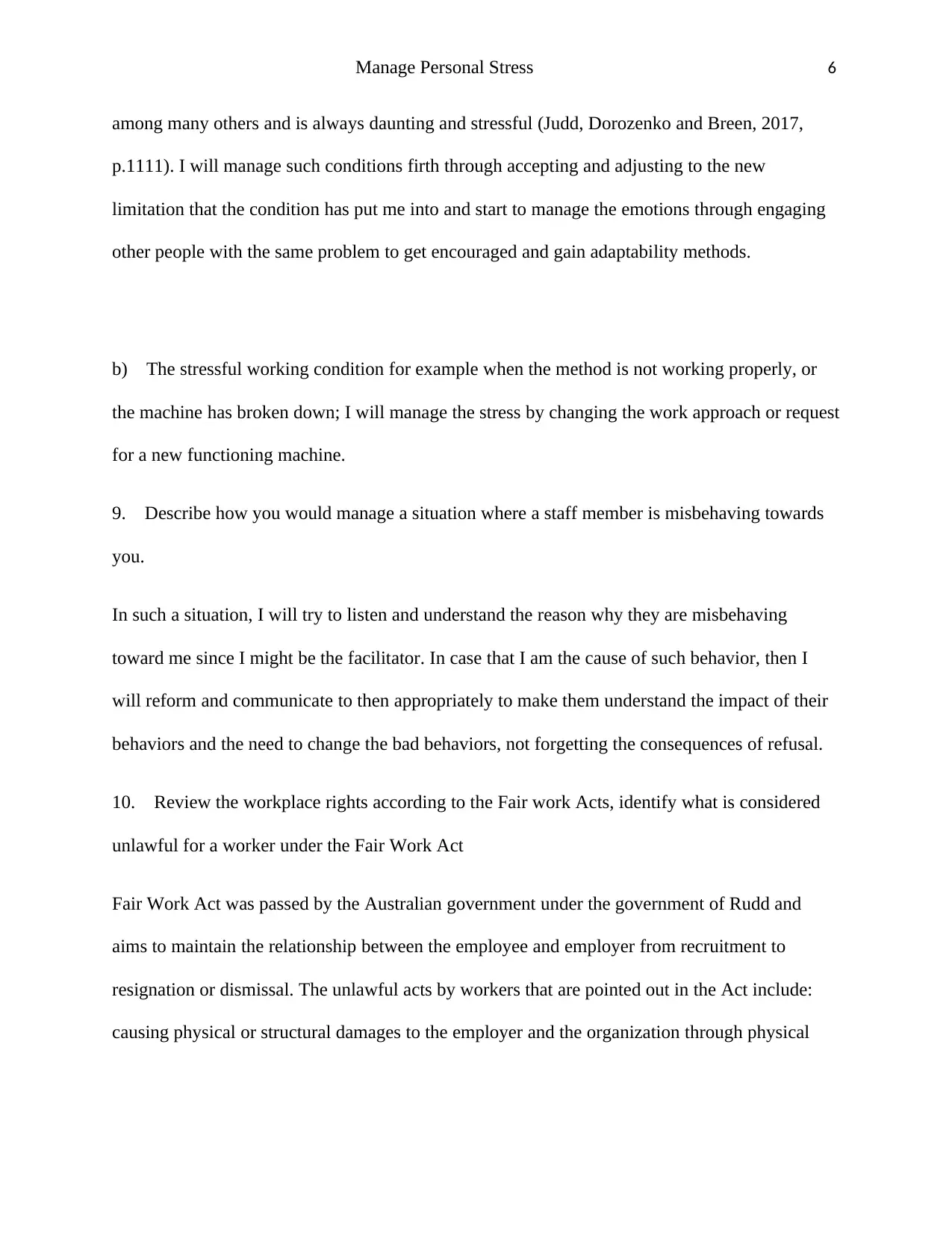
Manage Personal Stress 6
among many others and is always daunting and stressful (Judd, Dorozenko and Breen, 2017,
p.1111). I will manage such conditions firth through accepting and adjusting to the new
limitation that the condition has put me into and start to manage the emotions through engaging
other people with the same problem to get encouraged and gain adaptability methods.
b) The stressful working condition for example when the method is not working properly, or
the machine has broken down; I will manage the stress by changing the work approach or request
for a new functioning machine.
9. Describe how you would manage a situation where a staff member is misbehaving towards
you.
In such a situation, I will try to listen and understand the reason why they are misbehaving
toward me since I might be the facilitator. In case that I am the cause of such behavior, then I
will reform and communicate to then appropriately to make them understand the impact of their
behaviors and the need to change the bad behaviors, not forgetting the consequences of refusal.
10. Review the workplace rights according to the Fair work Acts, identify what is considered
unlawful for a worker under the Fair Work Act
Fair Work Act was passed by the Australian government under the government of Rudd and
aims to maintain the relationship between the employee and employer from recruitment to
resignation or dismissal. The unlawful acts by workers that are pointed out in the Act include:
causing physical or structural damages to the employer and the organization through physical
among many others and is always daunting and stressful (Judd, Dorozenko and Breen, 2017,
p.1111). I will manage such conditions firth through accepting and adjusting to the new
limitation that the condition has put me into and start to manage the emotions through engaging
other people with the same problem to get encouraged and gain adaptability methods.
b) The stressful working condition for example when the method is not working properly, or
the machine has broken down; I will manage the stress by changing the work approach or request
for a new functioning machine.
9. Describe how you would manage a situation where a staff member is misbehaving towards
you.
In such a situation, I will try to listen and understand the reason why they are misbehaving
toward me since I might be the facilitator. In case that I am the cause of such behavior, then I
will reform and communicate to then appropriately to make them understand the impact of their
behaviors and the need to change the bad behaviors, not forgetting the consequences of refusal.
10. Review the workplace rights according to the Fair work Acts, identify what is considered
unlawful for a worker under the Fair Work Act
Fair Work Act was passed by the Australian government under the government of Rudd and
aims to maintain the relationship between the employee and employer from recruitment to
resignation or dismissal. The unlawful acts by workers that are pointed out in the Act include:
causing physical or structural damages to the employer and the organization through physical
⊘ This is a preview!⊘
Do you want full access?
Subscribe today to unlock all pages.

Trusted by 1+ million students worldwide
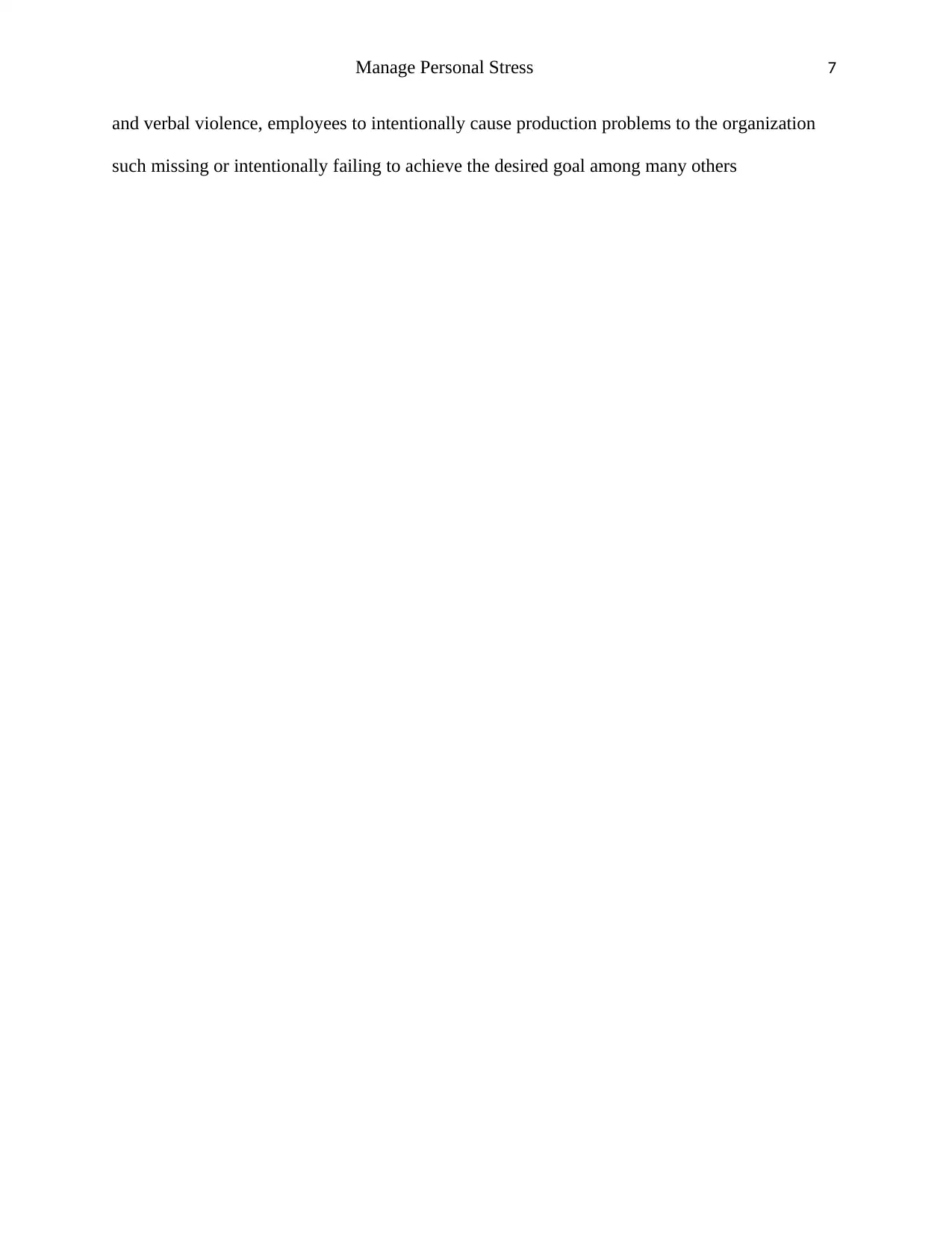
Manage Personal Stress 7
and verbal violence, employees to intentionally cause production problems to the organization
such missing or intentionally failing to achieve the desired goal among many others
and verbal violence, employees to intentionally cause production problems to the organization
such missing or intentionally failing to achieve the desired goal among many others
Paraphrase This Document
Need a fresh take? Get an instant paraphrase of this document with our AI Paraphraser
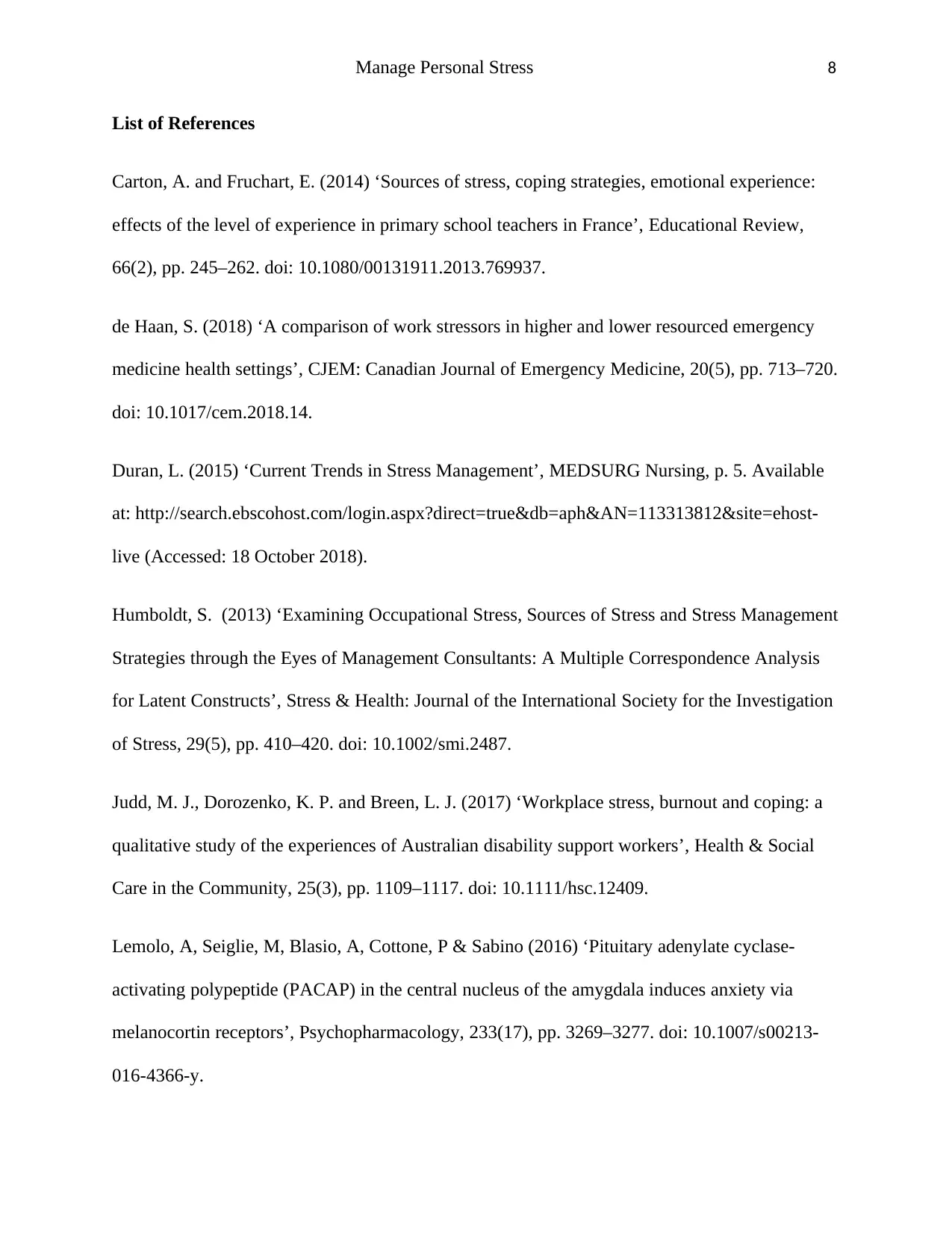
Manage Personal Stress 8
List of References
Carton, A. and Fruchart, E. (2014) ‘Sources of stress, coping strategies, emotional experience:
effects of the level of experience in primary school teachers in France’, Educational Review,
66(2), pp. 245–262. doi: 10.1080/00131911.2013.769937.
de Haan, S. (2018) ‘A comparison of work stressors in higher and lower resourced emergency
medicine health settings’, CJEM: Canadian Journal of Emergency Medicine, 20(5), pp. 713–720.
doi: 10.1017/cem.2018.14.
Duran, L. (2015) ‘Current Trends in Stress Management’, MEDSURG Nursing, p. 5. Available
at: http://search.ebscohost.com/login.aspx?direct=true&db=aph&AN=113313812&site=ehost-
live (Accessed: 18 October 2018).
Humboldt, S. (2013) ‘Examining Occupational Stress, Sources of Stress and Stress Management
Strategies through the Eyes of Management Consultants: A Multiple Correspondence Analysis
for Latent Constructs’, Stress & Health: Journal of the International Society for the Investigation
of Stress, 29(5), pp. 410–420. doi: 10.1002/smi.2487.
Judd, M. J., Dorozenko, K. P. and Breen, L. J. (2017) ‘Workplace stress, burnout and coping: a
qualitative study of the experiences of Australian disability support workers’, Health & Social
Care in the Community, 25(3), pp. 1109–1117. doi: 10.1111/hsc.12409.
Lemolo, A, Seiglie, M, Blasio, A, Cottone, P & Sabino (2016) ‘Pituitary adenylate cyclase-
activating polypeptide (PACAP) in the central nucleus of the amygdala induces anxiety via
melanocortin receptors’, Psychopharmacology, 233(17), pp. 3269–3277. doi: 10.1007/s00213-
016-4366-y.
List of References
Carton, A. and Fruchart, E. (2014) ‘Sources of stress, coping strategies, emotional experience:
effects of the level of experience in primary school teachers in France’, Educational Review,
66(2), pp. 245–262. doi: 10.1080/00131911.2013.769937.
de Haan, S. (2018) ‘A comparison of work stressors in higher and lower resourced emergency
medicine health settings’, CJEM: Canadian Journal of Emergency Medicine, 20(5), pp. 713–720.
doi: 10.1017/cem.2018.14.
Duran, L. (2015) ‘Current Trends in Stress Management’, MEDSURG Nursing, p. 5. Available
at: http://search.ebscohost.com/login.aspx?direct=true&db=aph&AN=113313812&site=ehost-
live (Accessed: 18 October 2018).
Humboldt, S. (2013) ‘Examining Occupational Stress, Sources of Stress and Stress Management
Strategies through the Eyes of Management Consultants: A Multiple Correspondence Analysis
for Latent Constructs’, Stress & Health: Journal of the International Society for the Investigation
of Stress, 29(5), pp. 410–420. doi: 10.1002/smi.2487.
Judd, M. J., Dorozenko, K. P. and Breen, L. J. (2017) ‘Workplace stress, burnout and coping: a
qualitative study of the experiences of Australian disability support workers’, Health & Social
Care in the Community, 25(3), pp. 1109–1117. doi: 10.1111/hsc.12409.
Lemolo, A, Seiglie, M, Blasio, A, Cottone, P & Sabino (2016) ‘Pituitary adenylate cyclase-
activating polypeptide (PACAP) in the central nucleus of the amygdala induces anxiety via
melanocortin receptors’, Psychopharmacology, 233(17), pp. 3269–3277. doi: 10.1007/s00213-
016-4366-y.
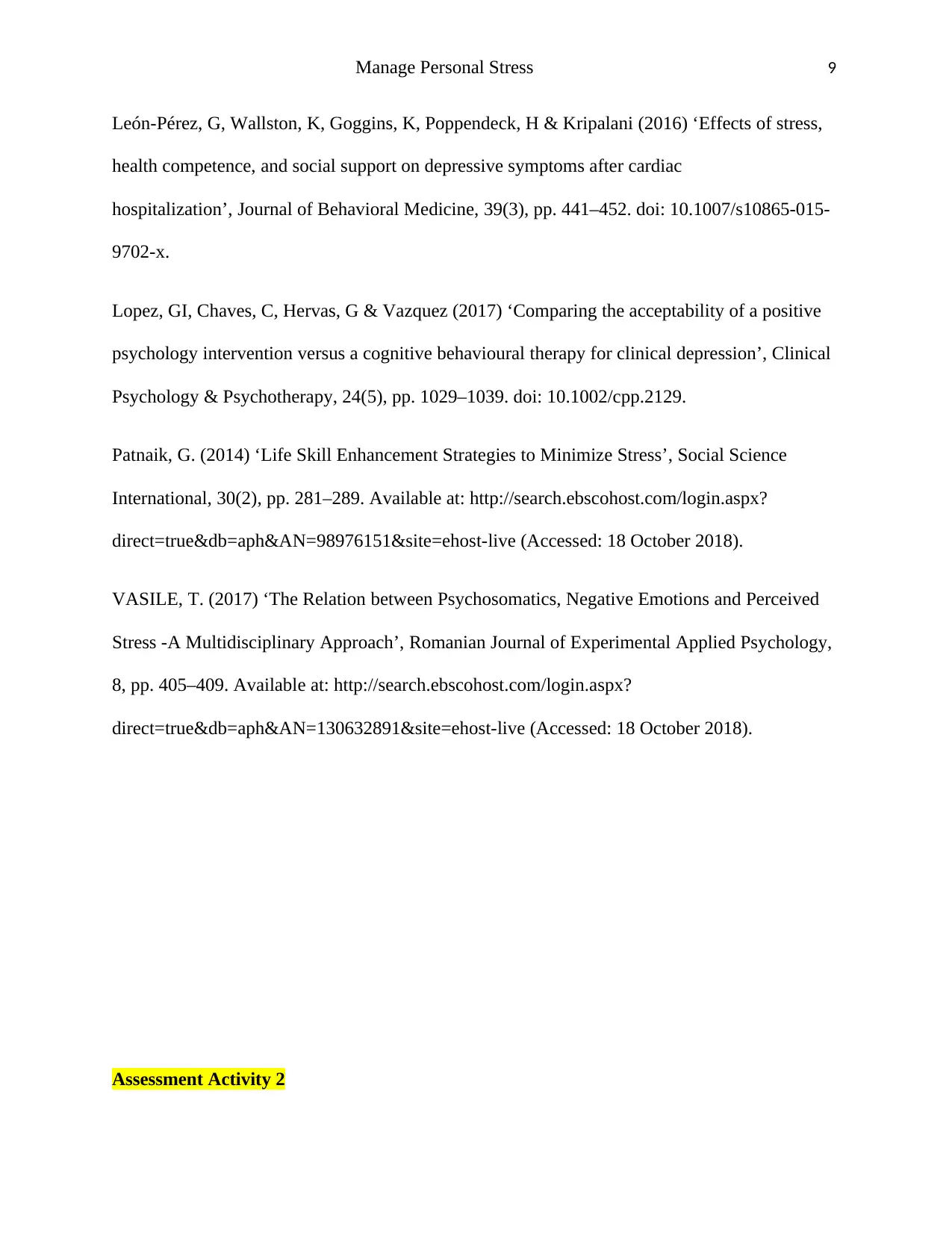
Manage Personal Stress 9
León-Pérez, G, Wallston, K, Goggins, K, Poppendeck, H & Kripalani (2016) ‘Effects of stress,
health competence, and social support on depressive symptoms after cardiac
hospitalization’, Journal of Behavioral Medicine, 39(3), pp. 441–452. doi: 10.1007/s10865-015-
9702-x.
Lopez, GI, Chaves, C, Hervas, G & Vazquez (2017) ‘Comparing the acceptability of a positive
psychology intervention versus a cognitive behavioural therapy for clinical depression’, Clinical
Psychology & Psychotherapy, 24(5), pp. 1029–1039. doi: 10.1002/cpp.2129.
Patnaik, G. (2014) ‘Life Skill Enhancement Strategies to Minimize Stress’, Social Science
International, 30(2), pp. 281–289. Available at: http://search.ebscohost.com/login.aspx?
direct=true&db=aph&AN=98976151&site=ehost-live (Accessed: 18 October 2018).
VASILE, T. (2017) ‘The Relation between Psychosomatics, Negative Emotions and Perceived
Stress -A Multidisciplinary Approach’, Romanian Journal of Experimental Applied Psychology,
8, pp. 405–409. Available at: http://search.ebscohost.com/login.aspx?
direct=true&db=aph&AN=130632891&site=ehost-live (Accessed: 18 October 2018).
Assessment Activity 2
León-Pérez, G, Wallston, K, Goggins, K, Poppendeck, H & Kripalani (2016) ‘Effects of stress,
health competence, and social support on depressive symptoms after cardiac
hospitalization’, Journal of Behavioral Medicine, 39(3), pp. 441–452. doi: 10.1007/s10865-015-
9702-x.
Lopez, GI, Chaves, C, Hervas, G & Vazquez (2017) ‘Comparing the acceptability of a positive
psychology intervention versus a cognitive behavioural therapy for clinical depression’, Clinical
Psychology & Psychotherapy, 24(5), pp. 1029–1039. doi: 10.1002/cpp.2129.
Patnaik, G. (2014) ‘Life Skill Enhancement Strategies to Minimize Stress’, Social Science
International, 30(2), pp. 281–289. Available at: http://search.ebscohost.com/login.aspx?
direct=true&db=aph&AN=98976151&site=ehost-live (Accessed: 18 October 2018).
VASILE, T. (2017) ‘The Relation between Psychosomatics, Negative Emotions and Perceived
Stress -A Multidisciplinary Approach’, Romanian Journal of Experimental Applied Psychology,
8, pp. 405–409. Available at: http://search.ebscohost.com/login.aspx?
direct=true&db=aph&AN=130632891&site=ehost-live (Accessed: 18 October 2018).
Assessment Activity 2
⊘ This is a preview!⊘
Do you want full access?
Subscribe today to unlock all pages.

Trusted by 1+ million students worldwide
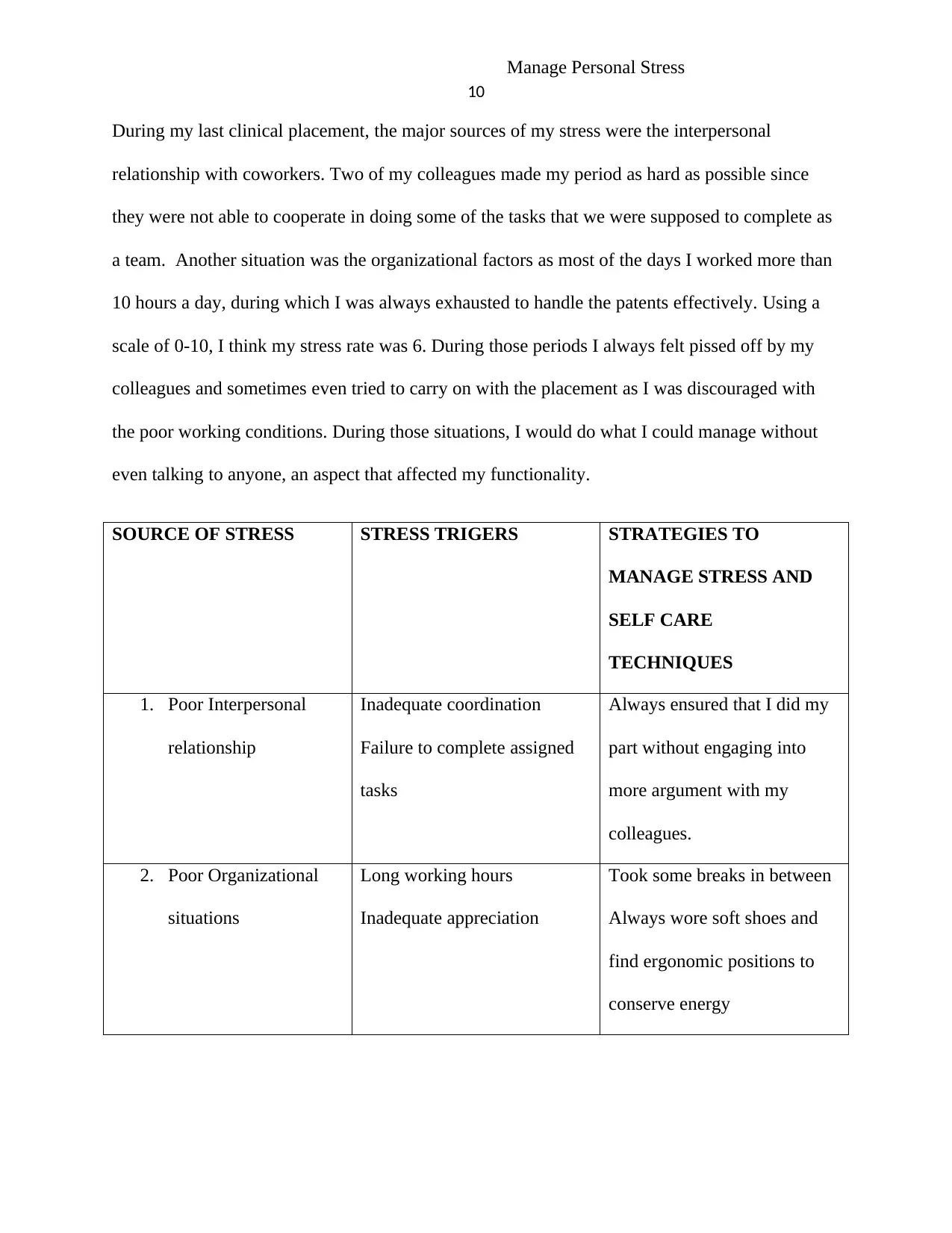
Manage Personal Stress
10
During my last clinical placement, the major sources of my stress were the interpersonal
relationship with coworkers. Two of my colleagues made my period as hard as possible since
they were not able to cooperate in doing some of the tasks that we were supposed to complete as
a team. Another situation was the organizational factors as most of the days I worked more than
10 hours a day, during which I was always exhausted to handle the patents effectively. Using a
scale of 0-10, I think my stress rate was 6. During those periods I always felt pissed off by my
colleagues and sometimes even tried to carry on with the placement as I was discouraged with
the poor working conditions. During those situations, I would do what I could manage without
even talking to anyone, an aspect that affected my functionality.
SOURCE OF STRESS STRESS TRIGERS STRATEGIES TO
MANAGE STRESS AND
SELF CARE
TECHNIQUES
1. Poor Interpersonal
relationship
Inadequate coordination
Failure to complete assigned
tasks
Always ensured that I did my
part without engaging into
more argument with my
colleagues.
2. Poor Organizational
situations
Long working hours
Inadequate appreciation
Took some breaks in between
Always wore soft shoes and
find ergonomic positions to
conserve energy
10
During my last clinical placement, the major sources of my stress were the interpersonal
relationship with coworkers. Two of my colleagues made my period as hard as possible since
they were not able to cooperate in doing some of the tasks that we were supposed to complete as
a team. Another situation was the organizational factors as most of the days I worked more than
10 hours a day, during which I was always exhausted to handle the patents effectively. Using a
scale of 0-10, I think my stress rate was 6. During those periods I always felt pissed off by my
colleagues and sometimes even tried to carry on with the placement as I was discouraged with
the poor working conditions. During those situations, I would do what I could manage without
even talking to anyone, an aspect that affected my functionality.
SOURCE OF STRESS STRESS TRIGERS STRATEGIES TO
MANAGE STRESS AND
SELF CARE
TECHNIQUES
1. Poor Interpersonal
relationship
Inadequate coordination
Failure to complete assigned
tasks
Always ensured that I did my
part without engaging into
more argument with my
colleagues.
2. Poor Organizational
situations
Long working hours
Inadequate appreciation
Took some breaks in between
Always wore soft shoes and
find ergonomic positions to
conserve energy
Paraphrase This Document
Need a fresh take? Get an instant paraphrase of this document with our AI Paraphraser
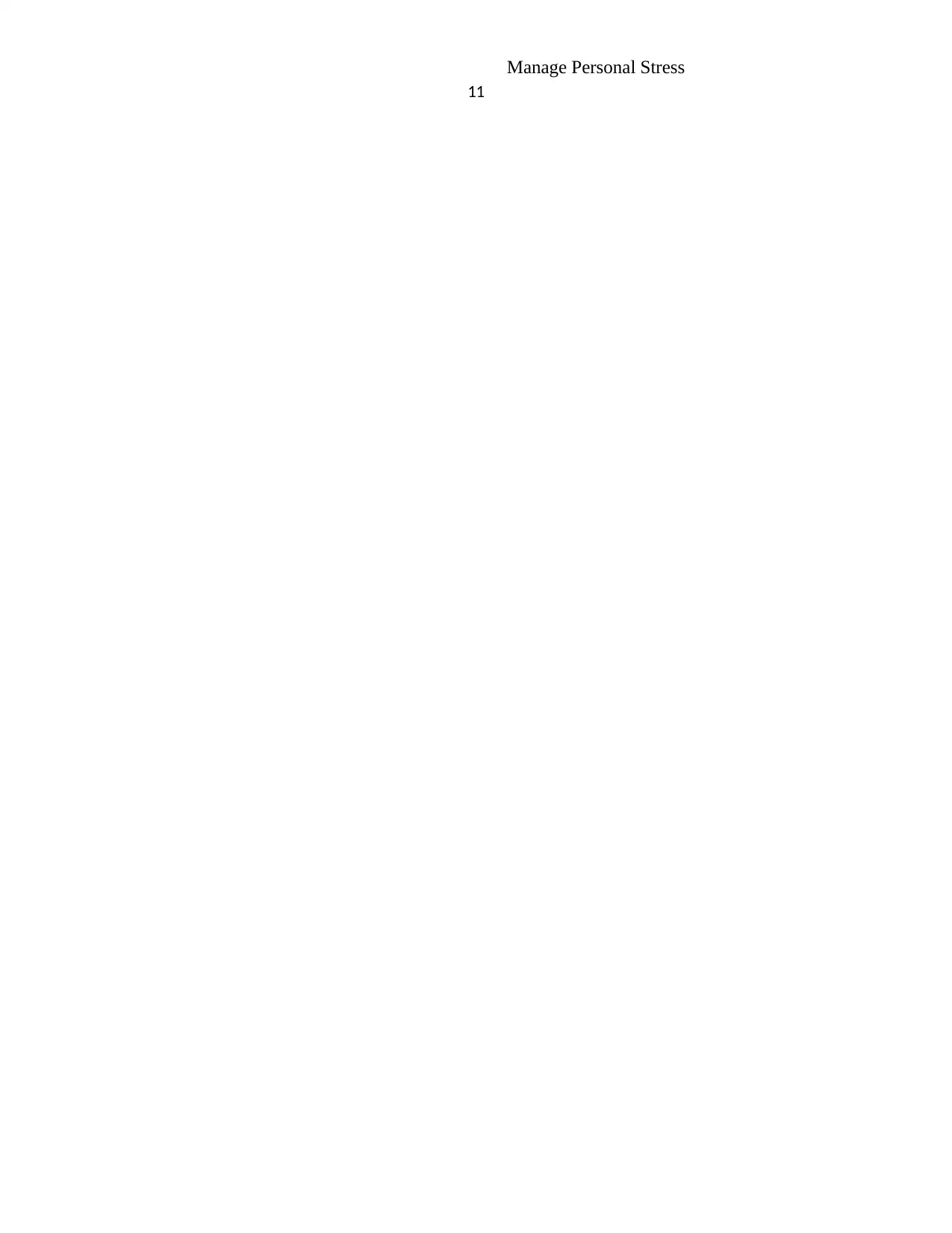
Manage Personal Stress
11
11
1 out of 11
Related Documents
Your All-in-One AI-Powered Toolkit for Academic Success.
+13062052269
info@desklib.com
Available 24*7 on WhatsApp / Email
![[object Object]](/_next/static/media/star-bottom.7253800d.svg)
Unlock your academic potential
Copyright © 2020–2025 A2Z Services. All Rights Reserved. Developed and managed by ZUCOL.





